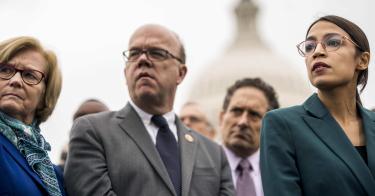The Green New Deal has drawn a lot of criticism — and rightly so.
Although this deal has nearly zero chance of passing Congress, the ideas it promotes would cause a great deal of costly damage if adopted. Fully detailing the flaws in the GND, and its accompanying FAQ document, would easily fill a book, so let’s focus on an aspect that concerns just about every American: transportation.
The GND calls for the expanded use of electric vehicles, as well as more public transportation and high-speed rail (though it’s very short on the details of how this would be accomplished). None of those would be unusual proposals from big-government politicians. However, the FAQ clarifies the scale of these statements: “Build (electric vehicle) charging stations everywhere;” “build out high-speed rail at a scale where air travel stops becoming necessary;” “affordable public transit available to all;”replace every combustion-engine vehicle.”
Although the proposals in the FAQ are radical, they’re exactly what would be necessary to fulfill the stated purpose of the plan: to reduce carbon emissions to nearly zero and institute the kind of government controls championed by the purveyor of the first New Deal, President Franklin D. Roosevelt.
Yet each of these items is so wildly unrealistic that you have to wonder how familiar the authors are with life away from coastal urban centers. Let’s go back to the high-speed rail, which only members of the Acela Corridor, the train track from Boston to New York to Washington, would think plausible or desirable. High-speed rail has significant environmental and fiscal costs. This has been demonstrated in eye-popping fashion by the California bullet train project, which fell prey to exactly the cost overruns and construction delays that plague nearly all government infrastructure projects.
If high-speed rail didn’t make sense for a wealthy, high-population area such as coastal California, it makes even less sense for the nation’s heartland. The expense it would take to build high-speed rail lines connecting every city in the country large enough to have an airport, followed by continual operation subsidies, would be stratospheric. The only way to put a serious dent in the cross-country flights that burn the most jet fuel would be through exorbitant taxes or outright bans.
“Affordable public transit for all” similarly displays a decidedly urban-centric viewpoint. Bus and rail service in major metropolitan areas are prone to dysfunction, yet are at least within the realm of possibility. Public transit for residents of every suburb, exurb and small town would be wildly expensive, inefficient and inconvenient. Do we imagine fleets of buses roaming the vast expanses of Wyoming, Kansas and the Dakotas in a vain search for passengers?
What about “charging stations everywhere”? Well, most mid-sized electric cars can only travel 90-125 miles on a charge, less than half the distance of a fully fueled gas-powered car. This would necessitate having exponentially more charging stations than the current number of gas stations to ensure comprehensive nationwide coverage. That would be a serious and costly undertaking, considering that there are roughly 120,000 gas stations in the country. Individual charging stations for home use typically cost thousands of dollars apiece.
Combine the cost of more robust stations designed for mass use with government proclivities for waste that yield million-dollar bus stops, and this idea becomes costly in a hurry.
And what about the goal to “replace every combustion-engine vehicle”? First, it should go without saying that if the federal government wants everyone to drive an electric vehicle, it wants nobody to drive a non-electric vehicle. New, high-end electric vehicles hooked up to high-end charging stations can still need over half an hour for a less-than-complete charge. Low-end vehicles drawing from standard charging stations require hours to charge.
When one combines long charging times with the shorter range that electrics have compared to gas-powered automobiles, the inconvenience rural Americans would be burdened with is easy to see. In addition, crony capitalist electric vehicle subsidies would force Americans to pay for being inconvenienced.
Ultimately, the Green New Deal seeks to use the issue of the environment to impose a grand vision for a planned society — one with high taxes, less choice and even more reliance on politicians in Washington, D.C. America deserves a better, freer future than that.
This piece originally appeared in The Miami Herald



